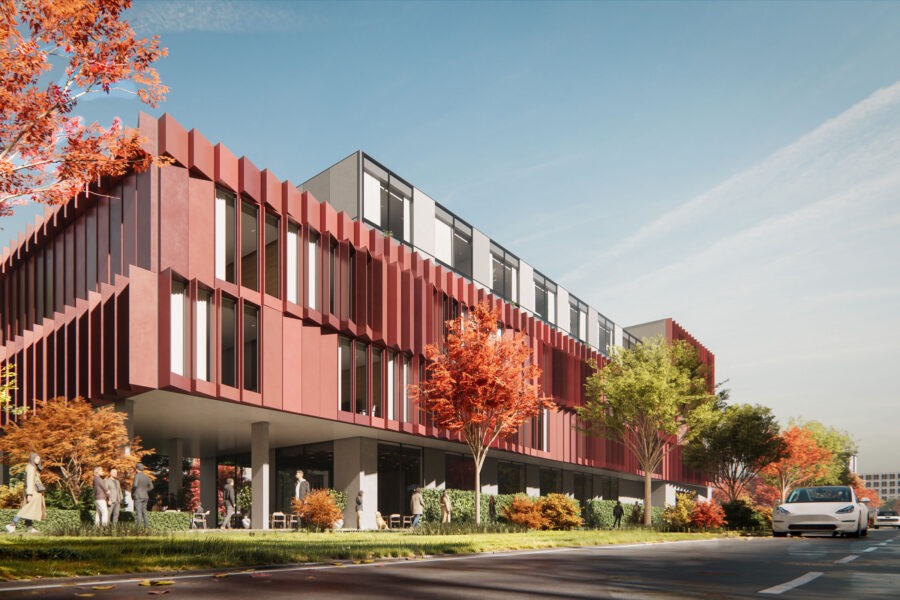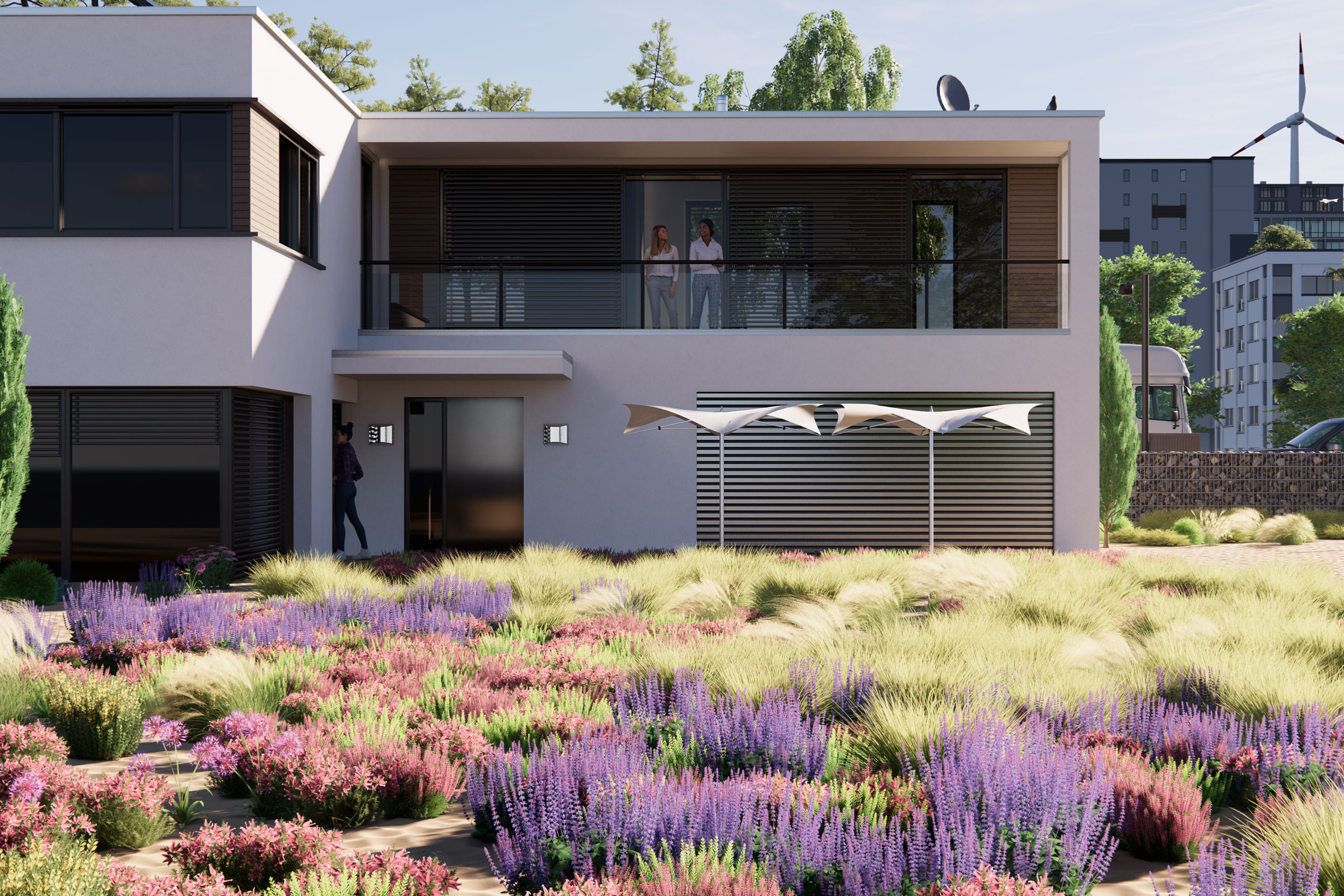Story at a glance:
- AI in architecture enables engineers and architects to create more efficiently while streamlining workflows among those involved in a building’s design, planning, or construction.
- According to a recent survey, two-thirds of people in the design and architecture professions already using AI are self-taught.
- Generative design is an example of how architects use AI algorithms to generate several possible designs based on inputted data.
AI in architecture is quickly revolutionizing the profession. In fact, 46% of the 1,227 designers surveyed in a study commissioned by Chaos—a leading rendering and simulation software developer—through Architizer reported already using AI tools for their projects, and 24% plan on using it soon. AI in architecture seems to be driven by self-learning, as 60% of survey respondents reported having no formal training in AI.
In this article we explore current trends, tips, and examples of the AI being used in architecture.
What is AI?

Enscape’s virtual reality plugin uses NVIDIA’s Deep Learning Super Sampling technology, an AI-powered rendering technology whose deep learning neural network helps provide ultra high-resolution ray-tracing and improve graphics performance. Photo courtesy of Enscape
In an extremely broad sense, artificial intelligence (AI) simply refers to intelligence exhibited by machines, with a particular emphasis on computer systems. “AI is a catchall term for a set of technologies that make computers do things that are thought to require intelligence when done by people,” according to the MIT Technology Review.
Diving a little deeper, AI may be conceptualized as a rapidly expanding field of research within computer science, one whose primary focus is on the study and development of software which enables computers and other machines to actively “perceive” their environments and learn from them so that they can complete a specific task or perform certain functions. Almost all modern AI programs are rooted in machine learning, which enables systems to learn autonomously—without being explicitly programmed to do so—by feeding them large datasets; the more data a system receives, the better it is able to adapt, adjust, and improve itself over time.
AI is still very much in its infancy and ever-changing. The current state of AI is, for example, not without mistakes—from facial recognition programs misidentifying people to driverless cars causing accidents.
What is AI in Architecture?

Chaos’ Enscape is a real-time rendering software designed for architects that makes use of artificial intelligence in various ways. Rendering courtesy of Enscape
One industry that has recently begun experimenting with artificial intelligence software is the AEC sector. There are a multitude of ways in which AI may be used in architecture and design, including:
- Assisting designers, engineers, and architects to imagine more innovative, cost-effective, or creative solutions
- Creating virtual 3D models or renderings
- Searching for new design trends and patterns
- Optimizing materials for cost, energy efficiency, et cetera.
- Running tedious calculations (e.g. solar studies, lighting simulations, energy consumption estimates, etc.)
- Analyzing large datasets and formulating new insights from them
When using AI for any of these reasons, architects and designers are able to explain their plans and communicate their designs more effectively to clients.
“As a culture we’ve all gotten so much more visual with things like Instagram and TikTok. Our attention spans are shorter and being able to showcase projects quickly and give people an overview, you can really share the story so much quicker without having to walk people through a potentially dense presentation or show them a series of plans that may be hard for the average person to interpret,” Caoimhe Loftus, digital lead at Arcadis—the global design and consultancy firm that developed the CLIMATESCOUT App—told gb&d in a previous publication.
Current Trends in AI in Architecture
There’s no question that AI is making waves in design and architecture. These are a couple of trends.
1. Augmented reality (AR) combined with virtual reality (VR) technology will overlay digital information onto the physical world. Designers will be able to see how their designs will or will not sync with the existing environment pre-construction.
2. AI may also be used by urban planners to design entire cityscapes. It may incorporate climate data to predict how current or future green infrastructure will protect cities from storm surges, or predict the degree of structural integrity buildings should have to be resilient in the face of climatic challenges.
Examples of AI in Architecture

The Beck Group was the RiverSouth project’s architect and general contractor, emphasizing a commitment to human health, wellness, and comfort to increase occupant satisfaction and reduce environmental impact. Known as the smartest building in Austin, the office tower makes use of an AI-powered building automation system from KODE Labs. Photo by Casey Dunn
Architects and designers possess a natural aptitude for experimentation. This trait makes them ideal AI explorers. Here are a few of the fruits of their discovery of AI in architecture.
AI in Data Analysis & Automation

Nest thermostats utilize AI to analyze HVAC data and use patterns to help improve energy efficiency. Photo courtesy of Nest
Though it may not be the flashiest or most groundbreaking use of AI in our modern world, artificial intelligence has potential to reshape the realm of data analytics as we know it. This is because AI—and machine learning in particular—is capable of processing extremely large quantities of structured, semi-structured, and unstructured data faster and more accurately than traditional methods conducted by data analysts.
One way AI-driven analysis is being used in the AEC industry is in monitoring and tracking building performance metrics, such as those collected by building automation systems (BAS), or networks designed to automate certain building functions—such as heating and air conditioning, lighting, alarms, et cetera—via a single set of controls. The RiverSouth office tower in Austin, for example, makes extensive use of smart sensor technologies and boasts an impressive AI-powered BAS from KODE Labs.
“The building uses cutting-edge sensors connected to its automation system, effectively controlling air quality, heating, ventilation, air conditioning systems, lighting, and security,” Natalie Terrill, director of sustainability at The Beck Group—the firm who designed the project—wrote in a previous gb&d article. “Data collection from these systems is analyzed using artificial intelligence to predict and maintain the building’s energy efficiency and to improve performance.”
Using machine learning algorithms, KODE Labs’ Smart Building OS standardizes and analyzes the building’s live sensor-collected data, helping operation managers to visualize, schedule, and coordinate in real time. This ultimately helps facilitate smart scheduling of various building systems, optimizes operational energy consumption, predicts potential maintenance issues, and improves the user experience overall.
This same basic concept also applies to something like Google’s Nest Thermostat, which uses machine learning to analyze HVAC use patterns and automatically make micro-adjustments to help homeowners save money. “It’s always optimizing itself to meet your comfort demands and run the most efficient cycles,” Gene LaNois, general manager of the Professional Channel at Nest, previously told gb&d.
AI Asset Enhancement

This image was enhanced using the Chaos AI Enhancer tool. The tool uses artificial intelligence to enhance assets in Enscape, helping architects create more detailed visualizations for their clients. Rendering courtesy of Enscape
When it comes to communicating ideas effectively and efficiently with clients, visual aides are an invaluable tool—and AI can help in that department by ensuring architectural visualizations are as realistic, detailed, and true-to-life as possible.
Chaos, for example, has recently integrated AI-driven asset enhancement into their Enscape real-time-rendering software. “The Chaos AI Enhancer leverages artificial intelligence to improve the realism of Enscape assets, particularly people and vegetation, without compromising performance,” Ina Iontcheva, a content creator at Chaos, previously wrote for gb&dPRO. “The AI feature enhances your visualizations, bringing projects to life with just one click.”
The Chaos AI Enhancer tool allows users to export high-quality assets straight from Enscape and manage them via the Chaos Cloud instead of relying on a third-party solution. This not only helps streamline the process by keeping everything within the same design application, but also ensures superior results thanks to the tool’s intimate knowledge of the underlying scene.
AI in Virtual Reality

“Enscape’s VR is a game-changer in the design process, as it offers architects, designers, and clients a profound understanding of scale, proportion, and spatial relationships within the built environment,” says Chaos’ Andreea Lipan. Rendering courtesy of Chaos
In addition to real-time-rendering, Enscape has become a leader in integrating AI with virtual reality (VR) technology—another tool revolutionizing how architects share concepts and ideas with their clients.
“By immersing themselves in the virtual environment, clients can explore proposed projects comprehensively and use real-time feedback to make informed decisions about design elements, materials, and spatial configurations,” Andreea Lipan, product marketing manager at Chaos, previously told gb&d. “This eliminates misunderstandings that often arise from 2D documentation or static images, allowing clients to visualize projects effectively and participate actively in the design process.”
Since 2019 Enscape has supported and utilized NVIDIA RTX, a real-time ray-tracing tool that enhances the speed, accuracy, and overall realism of 3D models and animations—and when NVIDIA launched their Deep Learning Super Sampling (DLSS) technology in 2021, it was quickly adopted into Enscape 3.1. NVIDIA DLSS is an AI-powered rendering technology that uses a complex deep learning neural network to increase graphics performance and provide ultra-high-resolution ray-tracing. This allows Enscape to render at a lower resolution internally but still output clear, crisp high-resolution images for high-performance VR walkthroughs.
All in all, this means architects and design firms are able to create detailed, aesthetically-appealing visualizations that render quickly while still maintaining a high degree of real-time navigation. “With the integration of VR Enscape has democratized the perception of space—once a skill requiring extensive training in geometry and sketching. Now accessible instantly through a VR headset, individuals can perceive architectural designs with the acuity of an architect,” Lipan says.
AI Text-to-Image Generators

Text-to-image generators are a rapidly-evolving class of AI technology and use a combination of deep learning to models, natural language processing, and computer vision techniques to generate detailed images from text-based descriptions. This design features an AI text-to-image generated rendition of Arktura’s existing Arborisa ceiling cloud system. Image courtesy of Arktura
As perhaps one of the more well-known examples of AI, text-to-image generators use deep learning models to create detailed images based on text descriptions using computer vision techniques, natural language processing, and generative adversarial networks. Currently, text-to-image generators like DALL-E 2, Stable Diffusion, and Midjourney are considered to be amongst the most advanced.
AI text-to-image generators have promise within the AEC sector as they allow designers to quickly develop detailed visuals to show their clients. “With the right input an architect could enter a range of design requirements, such as the number of rooms, the desired layout, and the style of the building, and the AI generator could produce multiple designs that meet those requirements. These designs could then be further refined or combined to create the best possible solution that meets the client’s needs,” Majeda Alhinai, a Solutions Studio designer at Arktura, previously wrote for gb&d.
A leading manufacturer of innovative, sustainable architectural systems, Arktura is constantly evaluating and experimenting with new technologies to assist—but never replace—their Solutions Studio design team in developing custom solutions for any project. The company has recently added text-to-image generation to their toolkit, using it to quickly bring clients’ concepts and ideas to life early on in the creative process. Rather than act as the final design, these generated images function primarily as stepping stones for the team to then build off of and improve upon, ensuring that the finished product still contains distinctly human elements.
Generative Design AI
Generative AI in architecture uses algorithms to create a wide range of design options based on a user’s specific input parameters and huge quantities of other data such as site conditions and building codes to investigate every conceivable option, such as structure, materials, and production techniques, then optimize them. It can recommend, for example, a design that excels in a specific way for cost, weight, or load- bearing characteristics. In the process, architects and designers can select the design leading to more sustainable or energy efficient buildings with maximum structural integrity.
This type of AI automates time-consuming, repetitive tasks, like building modeling and simulation. By identifying the most economical features, generative can save you money. For instance, Deloitte predicts this technology may save up to 15% in construction costs.
Another benefit of generative AI is that it can do the work designers and architects would like to do if they had infinite time to consider all their options. Gen AI can literally create thousands of designs in seconds.
Tips for Using AI in Architecture

Arktura is one company that has embraced AI in the form of text-to-image generators. The company’s Solutions Studio uses it not as a solution itself, but as a tool to help clients quickly visualize their concepts and ideas. The generated designs are then improved upon and enhanced by the designers themselves. Rendering courtesy of Arktura
AI in architecture is here to stay, so it’s imperative to become skilled at using it. Here are a few tips to make AI in architecture work for you.
Become familiar with the latest AI tools suitable for use by designers and architects. For instance, some AI text-to-image generators are: DALL-E, Stable Diffusion, Midjourney, CLIP, and StyleGAN. They’re similar but unique. Explore which one(s) works best for you through trial and error.
Spend time experimenting with AI tools on a variety of projects and at all stages from conception to final build. Send your feedback to the tools’ makers so future iterations will be easier to work with and possess greater functionality.
Join or form a professional network using AI in architecture to share experiences and troubleshooting guidance.
Inquire about or coordinate in your firm formal training in AI for all team players.
Jeanne Yacoubou contributed to this article.




